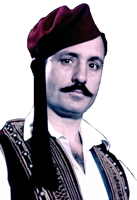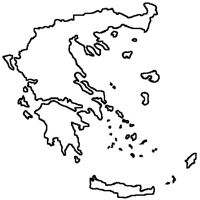
|
The Society of Folk Dance Historians (SFDH)
Greek Dance Then and Now
[
Home |
About |
Encyclopedia | CLICK AN IMAGE TO ENLARGE |

|
 When we consider Greek dance, we wonder, and try to discover, what it was in ancient times, both in its relationship to society and its basic function. Perhaps our best clues come from ancient sculptures and paintings and from contemporary Greek folk dance.
When we consider Greek dance, we wonder, and try to discover, what it was in ancient times, both in its relationship to society and its basic function. Perhaps our best clues come from ancient sculptures and paintings and from contemporary Greek folk dance.
These historical artifacts seem to parallel the forms of movement. Elements immediately evident are the striking similarities of the poses on some ancient vase paintings and the attitudes reflected in the Greek folk dances of today, the very definitive lines of dancers with their arms linked and hands held in a circle.
But since dance is a living art, we are always wondering what the movement might have been. Lillian Lawler sys, "In modern Greece and the Greek Islands and along the west Coast of Asia Minor, one may come upon what seem to be striking reminiscences of an ancient dance."
From the early stages of the circle dance, there emerged the orchestra (dancing place), derived from the ancient Greek word for dance, orchesis. It was from this orchestra that the amphitheater developed as a place where people gathered to be entertained.
When the element of participation changed to performance, there gradually developed a tradition of tragedy, or tragodia (goat song). These goat songs, or dithyrambs, were the earliest folk songs. Ancient poetry and rhythms like those in the early dithyrambs are still evident in Greek folk songs today. And the Byzantine rite of the Christian Orthodox faith is full of remnants of the kind of music that was both processional and liturgical, and similar to such early folk songs and instrumental music.
Since we know that oral tradition is passed faithfully from one generation to another, we can be reasonably sure that there is an unbroken link in the dance from ancient times to today.
 A final suggestion of evidence which might lead us to conclude that Greek dance can be traced to its origins by studying today's folk dances is that Greece, because of its many invaders, stubbornly maintained its traditions and, since Greece and the Balkan peninsula were not part of the European Renaissance, it avoided until the late 19th century the kind of artistic and cultural revolutionary influences that shook the rest of Europe.
A final suggestion of evidence which might lead us to conclude that Greek dance can be traced to its origins by studying today's folk dances is that Greece, because of its many invaders, stubbornly maintained its traditions and, since Greece and the Balkan peninsula were not part of the European Renaissance, it avoided until the late 19th century the kind of artistic and cultural revolutionary influences that shook the rest of Europe.
Research indicates the likelihood that remnants of many ancient rites survive in today's Greek folk dances. Though dance historians admit there have been changes, influences, additions, modifications and omissions, the form and basic style remain similar. One of the earliest researchers of Greek dance, C. Sakellarious, points out, "That our dances have not been deformed by those other invading peoples is shown by the 7/8 and 5/4 beat which is characteristic of Greek dances . . . . Today, after the liturgy in the church, the feast of the Virgin or the Saint is honored by the dancing of youths and maids. Nearly every district or island has its local dress and individual dance. And as in the past, so today each dance retains its particular rhythm unchanged."
As the dithyrambs which honored the god Dionysos developed a more dramatic nature, and the Korypheos took on the characteristics of the actor, the abstract element of the dance gave rise to the dramatic element. Here the leader of the Greek dance plays an important role. Hence the broken circle, allowing the leader, or korifeos, to express the feelings, emotions and instincts of the group.
Of particular interest today is the concept of therapy in dance. Very likely this idea existed in the dance even in ancient times. Activating the muscles through movement would induce certain secretions and chemical changes in the participants. Aristotle perceived in Greek tragedy the cleansing of the deepest emotions buried within the recesses of our unconscious which needed to be brought to the surface and expressed in art to maintain a healthy attitude to life.
Dance in every society serves a specific purpose. To understand Greek dance from ancient times to the present, we must see the function changing from sacred or religious to social or secular.
There are many areas in which Greek folk dance and Orff-Schulwerk are closely related. For example, a Schulwerk teacher writes, "The art of improvisation began to lag when a distinction arose between those who composed music, and those who performed it. The composer never ceased to improvise in his selection/rejection process of composition."
In Greek dance, improvisation is the most desirable goal for the dancers — improvisation within the confines of a musical form and set of dance "steps." The steps are not the ultimate goal. When steps dominate, then the dance remains only an exercise in technique.
The folk dance artist strives to use technique in order to create extemporaneous elements that speak from the inner soul. When this is accomplished in the Greek dance, the melody will create a response. Finally we listen to the lyrics which ultimately release the imagery and cause us to reflect on our own creative purpose.
It may apear difficult to see how this can be achieved in a circle dance when it is necessary to stay in line. But being in line and working together as a unit do not necessarily mean that we lose our sense of identity. If anything, the circle forces us to discover still another, greater one.
Perhaps the Orff-Schulwerk musician is one of the most integrated practitioners of integrated arts. He dutifully examines all the elements around him from nature to man and his creations and all the phenomena he can possibly relate to the sound of music. But his ultimate goal is to create a world of sound, and with this music to integrate the arts to that they are in constant flow, mutually enriching each other.
The dancer is also a musician and painter, even a sculptor, a poet of movement, or a dramatist, with a story unfolding in movement. Finally, we realize that the ultimate goal is not specialization in the arts but rather unification into one voice blending all the arts into one, the ultimate expression. When that is achieved, we are living in the true classical tradition.
Society challenges us to continue discovering ways to live more creatively in the midst of ever-increasing technological changes and the "new revolution." The important factor is to align our sensibilities with elements of music, dance, and the other arts, to recreate the total human experience needed for man to survive in such a society.
Dance is one way to find the ideal person from within, the person who exemplifies the best of what he is to all people. What I strive for through Greek dance is not a reconstruction of ancient forms, but rather, that the ancient forms contribute a sense of continuity and a foundation for a classical sense of values akin to that of ancient Greece, a goal we all share.
BIBLIOGRAPHY
- Lillian Lawler, The Dance in Ancient Greece (London: Adam and Black, 1964).
- Greek Dances, Our Link with Antiquity (Athens: Angelos Klissionis, 1966).
- Lographica and Didactca to Elinikon Horon (Thessaloniki: F. Berberidis Offset Co., 1972).
- C. Sakellarious, Fifty Greek Dances (Lithographer Papchrysanthou, Athens, 1940).
- Aristotle's Theory of Poetry and Fine Art (Butcher Dobver Press, 1951).
- E. Nichols, "Improvisation: key to Orff-Schulwerk" from Re-Echoes (AOSA, 1977).
This page © 2018 by Ron Houston.
Please do not copy any part of this page without including this copyright notice.
Please do not copy small portions out of context.
Please do not copy large portions without permission from Ron Houston.